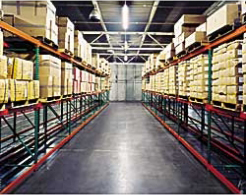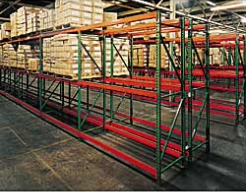
Pallets are a necessity for the proper operation of a warehouse. So it is paramount that these tools are protected from damage. Various forms of pallet racks achieve this.
Racks are usually columns that are structurally supported by beams and include multiple levels of shelves and a wire mesh deck that supports the pallets that are piled upon them.
There are four styles –- selective racks, drive-in or drive through racks, push back racks, and flow or gravity flow racks.
Pallet Rack Styles and Structures
A selective rack is probably the most common style of rack used. They are open in front to permit easy accessibility and include beams that provide the support system that holds the pallets. The system can be used in a variety of storage applications that include narrow aisle, standard, and deep reach arrangements.
Generally speaking, specialized narrow lift trucks are used with this type of rack and they are ideal for creating optimal space. The standard variety permits single deep loading; and deep reach is capable of handling double the storage amount of the standard system.
The Drive-in and Drive through racks are designed and constructed for high-density storage and are made of steel. They include space (or bay) for a forklift to gain access to the pallets stored on them.
Drive-in racks include only one entry or exist way for the forklift while the drive-through configuration allows the forklift to enter on both sides of the bay. Racks are generally loaded by the last in, first out process. Because of this these racks are ideal for nonperishable and low turnover products. Both types of racks rise from floor-to-ceiling.

Push back racking systems are manufactured of roll or structural form and are best for bulk storage. They can accommodate stored products that occupy or run two to five pallets deep and are several levels high. When a pallet is laid on the rack, the next pallet is pushed back on to the rails of the system. When the pallets are unloaded from the rails, they are pushed to the front of the assembly. The last-in, first-out process is also used to load them. Constructed with double lanes, these structures include inclined rails and sliding carts.
Flow racks a.k.a. gravity flow racks are commonly used for high-density storage. Items are stored in the last-in, first out method at the high end and
removed at the low end. The flow of the rack assures that the rotation of the products is performed automatically.
The system includes a gravity roller that forces the movement based on the load and a sloped plane. The lanes include brakes that control the movement of the items. It works on the principle of gravity, so there is no electric operation.
Choosing the Proper Pallet Rack Configuration
Experts like the American National Standards Institute suggest that you consider the cost of materials, the space and height available, and what inventory will be stored when selecting a pallet rack. Be certain that the different loading processes (first in, first out or last in, first out) must be matched with products that benefit from the method. Experts also suggest that you take into account environmental factors because some locations and outdoor conditions call for heavier or stronger structures.
